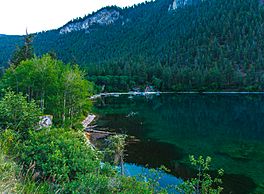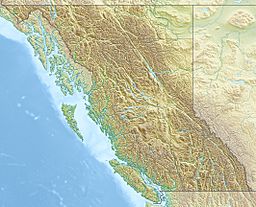Pavilion Lake facts for kids
Quick facts for kids Pavilion Lake |
|
|---|---|

A surface view of Pavilion Lake
|
|
| Location | British Columbia |
| Coordinates | 50°52′00″N 121°44′31″W / 50.86677°N 121.74191°W |
| Primary outflows | Pavilion Creek |
| Basin countries | Canada |
| Max. length | 5.8 kilometers (3.6 mi) |
| Max. width | 0.8 kilometers (0.50 mi) |
| Max. depth | 65 meters (213 ft) |
| Surface elevation | 820 meters (2,690 ft) |
Pavilion Lake is a freshwater lake found in Marble Canyon, British Columbia, Canada. It is home to special living rock formations called microbialites. These unique structures make the lake a very important place for scientific study.
Contents
Where is Pavilion Lake?
Pavilion Lake is located in British Columbia, Canada. You can find it between the towns of Lillooet and Cache Creek. It sits right along BC Highway 99.
There are some homes along the lake's eastern shore. Some of these are used for vacations. The lake is surrounded by tall cliffs of Marble Canyon. It is also near the forests of the northern Clear Range.
Local Communities and History
A tall rock called Chimney Rock also overlooks the lake. This rock, along with the lake and canyon, is very important to the local Indigenous communities. These include the Tskwaylaxw people from Pavilion and the Bonaparte band of Secwepemc people from Upper Hat Creek.
A special area for the Pavilion Band, including a rodeo and pow-wow ground, is located nearby. The lake and its surrounding area are now part of Marble Canyon Provincial Park. This helps protect its important scientific and cultural value.
What Makes Pavilion Lake Special?
Pavilion Lake has a unique water system. Water flows into it from underground creeks in Marble Canyon. The lake's water is very clear, and it does not have many plants or animals growing in it. This is because it is a "hard water" lake, meaning it has a lot of minerals.
The lake freezes over every year. It also mixes its water twice a year, which helps keep the water healthy. Pavilion Lake is quite deep, reaching about 65 meters (213 feet) at its deepest point.
Microbialites: Living Rocks
The most famous feature of Pavilion Lake is its colonies of microbialites. These are a type of stromatolite, which are ancient living structures. They look like rocky towers or mounds underwater.
These microbialites grow at different depths, from 5 to 55 meters (16 to 180 feet) below the surface. They grow very slowly, only about 0.05 millimeters (0.002 inches) each year. This slow growth has allowed them to form over thousands of years. Most of the living activity in these structures happens near their surface.
The special water conditions in the lake prevent many animals from eating the microbialites. This allows them to continue growing and thriving.
Scientific Research at Pavilion Lake
Because of its unique microbialites, Pavilion Lake has become a major site for scientific research. Scientists from around the world study the lake. This includes researchers from NASA and the Canadian Space Agency.
Their research is part of the Pavilion Lake Research Project. This project uses the lake to study how life might exist in extreme environments, similar to what might be found on other planets. Astronauts from the Canadian Space Agency have even trained here. They learn how to explore and collect samples in conditions that are similar to space missions.
See also
 In Spanish: Lago Pavilion para niños
In Spanish: Lago Pavilion para niños
- List of lakes of British Columbia
- Fraser Canyon
- Fountain, British Columbia
- Marble Canyon
- Pavilion Indian Band (Tskwalaxw First Nation)



